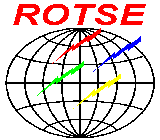 |
Gamma-Ray Bursts
|
|
This is a explanation
of the primary ROTSE science goals.
From the International Astronomical Union Circular No. 7100 (26-Jan-1999): "We observed the error box of GRB 990123 provided by the BACODINE Burst Position Notice (dated 23-Jan-99 09:46:59) using the ROTSE-I telephoto camera array located at Los Alamos. The first exposure began at 9h47m18s.30 UT (Jan. 23.407851), or 22.18 s after the nominal burst trigger time. A rapidly fading object was discovered at R.A. = 15h 25m30s.1, Decl. = +44o46'00" (equinox 2000.0), which is within one-third of a pixel of the optical counterpart reported by Odewahn et al. (IAUC 7094). The light curve for this object is relatively complex: the luminosity increases by 3 magnitudes between the first and second exposures. Exposure times and estimated V magnitudes for the first six exposures are as follows: Jan. 23.407851, 5 s,11.82; 23.408142, 5, 8.95; 23.408435, 5, 10.08; 23.410851, 75,13.22; 23.412764, 75, 14.00; 23.414677, 75, 14.53. Note that the ROTSE-I detector system uses an unfiltered broadband CCD, so that magnitude estimates are based on comparisons to catalogue values for nearby stars. Sky-patrol images of the same coordinates taken 133 min earlier showed no evidence of the transient to a limit of at least 2 mag deeper. A more extensive analysis of these data will be available in the near future. The discovery images are posted on the ROTSE Web page at: http://www.umich.edu/~rotse/gifs/grb990123/990123.gif."
| |